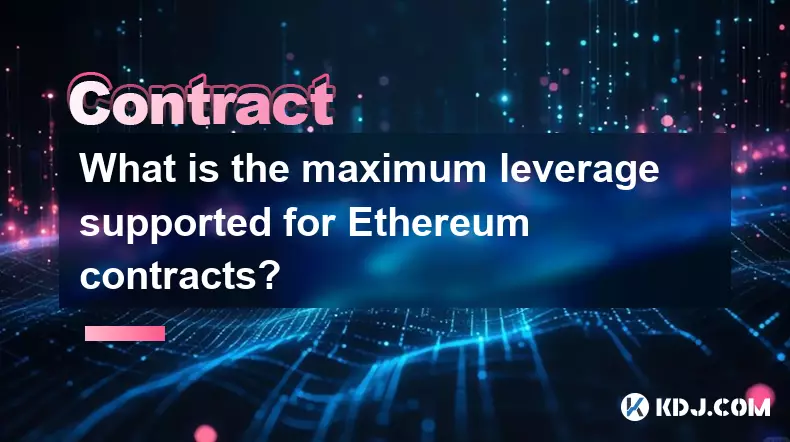-
 bitcoin
bitcoin $122090.672462 USD
1.59% -
 ethereum
ethereum $4493.758974 USD
0.56% -
 xrp
xrp $3.033145 USD
0.65% -
 tether
tether $1.000629 USD
0.00% -
 bnb
bnb $1169.854250 USD
7.07% -
 solana
solana $230.954786 USD
-0.19% -
 usd-coin
usd-coin $0.999785 USD
0.00% -
 dogecoin
dogecoin $0.256108 USD
-1.12% -
 tron
tron $0.342333 USD
-0.12% -
 cardano
cardano $0.859632 USD
-0.10% -
 hyperliquid
hyperliquid $48.932146 USD
-2.25% -
 chainlink
chainlink $22.345466 USD
-1.29% -
 ethena-usde
ethena-usde $1.000217 USD
-0.03% -
 avalanche
avalanche $31.203456 USD
1.93% -
 sui
sui $3.579145 USD
1.05%
What is the maximum leverage supported for Ethereum contracts?
Leverage in Ethereum derivatives amplifies gains and risks, with platforms offering up to 125x, though high leverage increases liquidation risk significantly.
Sep 24, 2025 at 04:00 am

Understanding Leverage in Ethereum Derivatives
1. Leverage in Ethereum-based derivative contracts allows traders to control large positions with a relatively small amount of capital. This amplifies both potential gains and risks, making it a powerful tool in speculative trading environments. Platforms offering Ethereum futures or perpetual swaps typically provide varying degrees of leverage depending on their risk models and market conditions.
2. The maximum leverage available can differ significantly across exchanges. Major centralized platforms such as Binance, Bybit, and OKX commonly offer up to 100x leverage on Ethereum perpetual contracts under certain margin modes. However, this level is usually only accessible for short-term trades and requires sophisticated risk management due to the high probability of liquidation.
3. Some decentralized derivatives protocols may impose lower leverage limits, often ranging between 5x and 25x, to maintain system stability and reduce systemic risk within over-collateralized frameworks. These platforms prioritize security and decentralization over aggressive trading capabilities, aligning with broader DeFi principles.
4. Regulatory considerations also influence leverage caps. In jurisdictions with stricter financial oversight, exchanges may voluntarily limit maximum leverage to comply with local laws or avoid scrutiny from authorities concerned about investor protection.
Risk Implications of High Leverage Trading
1. When using high leverage on Ethereum contracts, even minor price fluctuations can trigger automatic liquidations. A market move of less than 1% can erase an entire position at 100x leverage, emphasizing the fragility of highly leveraged trades.
2. Funding rates in perpetual swap markets become more volatile under extreme leverage usage, especially during periods of heightened market sentiment. Traders holding leveraged positions over extended periods may incur significant costs due to unfavorable funding payments.
3. Liquidation mechanisms vary by platform but generally involve partial or full closure of positions when margin balance falls below maintenance requirements. Some exchanges utilize insurance funds or socialized losses to cover deficits, though these practices are increasingly being replaced by auto-deleveraging systems.
4. Overuse of maximum leverage contributes to cascading sell-offs during sharp reversals, particularly evident during black swan events like the March 2020 crypto crash. Such episodes highlight how concentrated leverage exposure can destabilize short-term market dynamics.
Platform-Specific Leverage Policies
1. Binance supports up to 125x leverage on ETH/USDT perpetual contracts for users in specific margin tiers, though this is restricted based on account equity and trading volume. Newer accounts or those with limited history may face lower initial limits.
2. Bybit allows 100x leverage on its inverse and linear Ethereum contracts, with adjustable LTV (Loan-to-Value) ratios that dynamically affect allowable exposure. Users must maintain adequate collateral, especially during high-volatility sessions.
3. KuCoin offers tiered leverage options reaching 100x, but enforces stricter KYC verification for access to higher tiers. Their risk engine recalculates margin requirements in real time, adjusting effective leverage during rapid price movements.
4. dYdX, a decentralized exchange, historically capped Ethereum contract leverage at 20x, focusing on sustainable borrowing rates and minimizing protocol insolvency risk. Although v4 introduces greater flexibility, conservative parameters remain embedded in its design.
Frequently Asked Questions
What factors determine the actual leverage a trader can use?Available leverage depends on the exchange’s risk framework, user tier, position size, and current market volatility. Larger positions often receive lower maximum leverage to mitigate systemic exposure. Margin mode—cross vs isolated—also plays a critical role in determining usable leverage levels.
Can leverage be adjusted after opening a position?Yes, many platforms allow modification of leverage mid-trade without closing the position. Increasing leverage reduces the buffer against liquidation, while decreasing it enhances safety margins. This feature provides tactical flexibility but requires active monitoring.
How does funding rate impact leveraged Ethereum trades?Funding rates transfer value between long and short holders every eight hours. In bullish markets, longs pay shorts, increasing the cost of holding leveraged long positions. Sustained imbalances in order books amplify these payments, affecting profitability over time.
Are there differences between isolated and cross margin in leverage usage?Isolated margin allocates a fixed amount of collateral to a single position, limiting potential loss to that sum. Cross margin uses the entire wallet balance as collateral, enabling higher effective leverage but exposing all funds to liquidation risk if the position moves adversely.
Disclaimer:info@kdj.com
The information provided is not trading advice. kdj.com does not assume any responsibility for any investments made based on the information provided in this article. Cryptocurrencies are highly volatile and it is highly recommended that you invest with caution after thorough research!
If you believe that the content used on this website infringes your copyright, please contact us immediately (info@kdj.com) and we will delete it promptly.
- BlockDAG, DOGE, HYPE Sponsorship: Crypto Trends Shaping 2025
- 2025-10-01 00:25:13
- Deutsche Börse and Circle: A StableCoin Adoption Powerhouse in Europe
- 2025-10-01 00:25:13
- BlockDAG's Presale Buzz: Is It the Crypto to Watch in October 2025?
- 2025-10-01 00:30:13
- Bitcoin, Crypto, and IQ: When Genius Meets Digital Gold?
- 2025-10-01 00:30:13
- Stablecoins, American Innovation, and Wallet Tokens: The Next Frontier
- 2025-10-01 00:35:12
- NBU, Coins, and Crypto in Ukraine: A New Yorker's Take
- 2025-10-01 00:45:14
Related knowledge

What is the difference between futures and perpetual contracts for Bitcoin?
Oct 02,2025 at 11:54pm
Understanding Bitcoin Futures Contracts1. Bitcoin futures are derivative instruments that allow traders to speculate on the future price of Bitcoin at...

What is the best time to trade PEPE contracts?
Oct 03,2025 at 11:54am
Understanding PEPE Contract Volatility1. PEPE contracts exhibit extreme price fluctuations due to their meme-based nature and low market cap. Trading ...

What are the common mistakes to avoid with Bitcoincoin contracts?
Oct 03,2025 at 08:54am
Emerging Trends in the Cryptocurrency Market1. Decentralized finance (DeFi) platforms continue to expand their influence across the blockchain ecosyst...

What is the maintenance margin for Bitcoin contracts?
Oct 02,2025 at 01:36am
Decentralized Exchanges Gain Momentum in 20241. Decentralized exchanges (DEXs) have seen a significant rise in trading volume, surpassing centralized ...

How to use technical analysis for trading XRP contracts?
Oct 03,2025 at 01:18pm
Understanding Price Patterns in XRP Futures1. Identifying chart patterns such as triangles, head and shoulders, and double tops or bottoms can provide...

What does "longing" PEPE contracts mean?
Oct 03,2025 at 11:54pm
Understanding Decentralized Exchanges in the Crypto Ecosystem1. Decentralized exchanges (DEXs) operate without a central authority, allowing users to ...

What is the difference between futures and perpetual contracts for Bitcoin?
Oct 02,2025 at 11:54pm
Understanding Bitcoin Futures Contracts1. Bitcoin futures are derivative instruments that allow traders to speculate on the future price of Bitcoin at...

What is the best time to trade PEPE contracts?
Oct 03,2025 at 11:54am
Understanding PEPE Contract Volatility1. PEPE contracts exhibit extreme price fluctuations due to their meme-based nature and low market cap. Trading ...

What are the common mistakes to avoid with Bitcoincoin contracts?
Oct 03,2025 at 08:54am
Emerging Trends in the Cryptocurrency Market1. Decentralized finance (DeFi) platforms continue to expand their influence across the blockchain ecosyst...

What is the maintenance margin for Bitcoin contracts?
Oct 02,2025 at 01:36am
Decentralized Exchanges Gain Momentum in 20241. Decentralized exchanges (DEXs) have seen a significant rise in trading volume, surpassing centralized ...

How to use technical analysis for trading XRP contracts?
Oct 03,2025 at 01:18pm
Understanding Price Patterns in XRP Futures1. Identifying chart patterns such as triangles, head and shoulders, and double tops or bottoms can provide...

What does "longing" PEPE contracts mean?
Oct 03,2025 at 11:54pm
Understanding Decentralized Exchanges in the Crypto Ecosystem1. Decentralized exchanges (DEXs) operate without a central authority, allowing users to ...
See all articles










































































